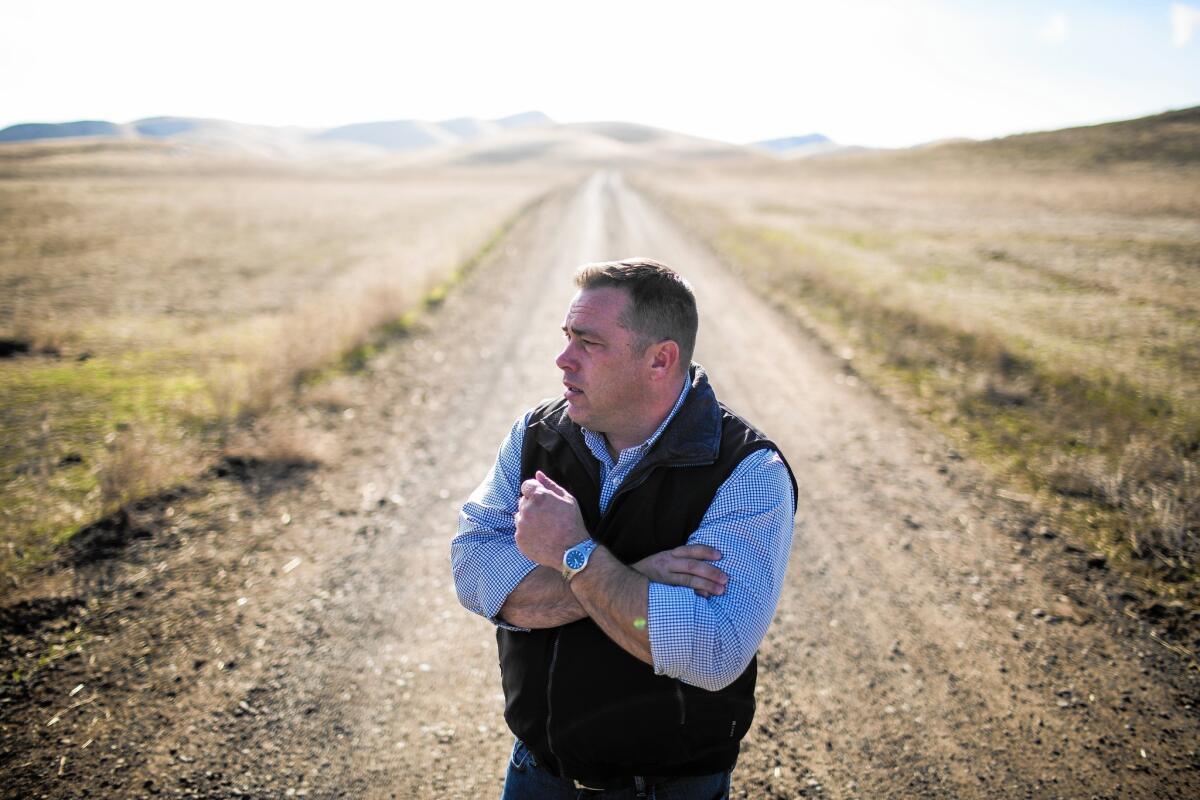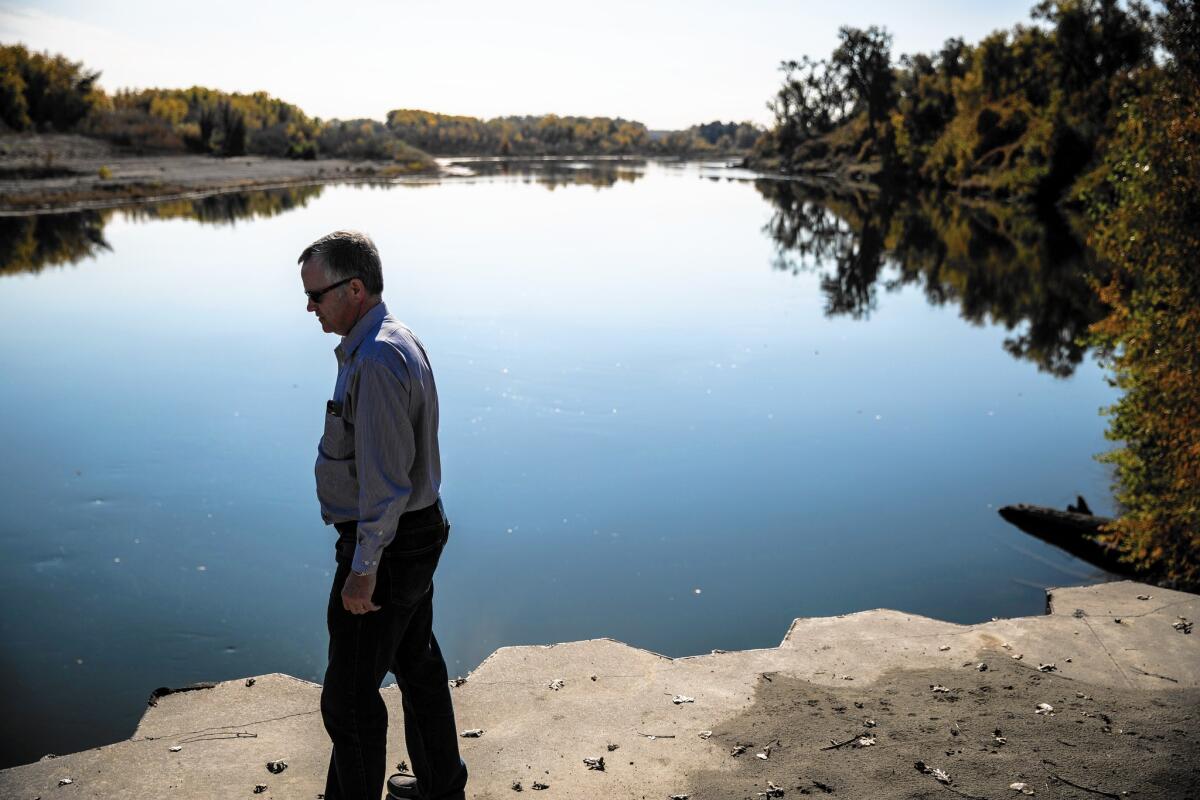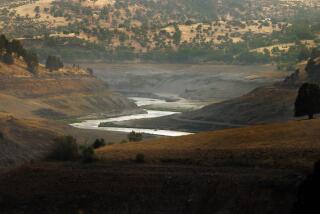Is the era of dam-building over? Backers of several major projects say it shouldn’t be.

Reporting From Sites, Calif. — This tranquil ranching valley lies 15 miles west of the Sacramento River. A one-lane bridge spans a dried-up creek at the valley entrance. But when Jeff Sutton stands there, he imagines water, lots of it.
Never mind that talk of flooding the Antelope Valley north of Sacramento and turning it into a reservoir is older than Sutton. The time has finally come, he says. “It’s the right project at the right place.”
Drought, climate change and environmental curbs on water deliveries are fueling campaigns for more water storage in California. Sites Reservoir — as it would be called after the tiny settlement it would wipe off the map — is one of a handful of resurgent proposals challenging the notion that the era of big dam building is over.
Water and Power is The Times’ guide to the drought. Sign up to get the free newsletter >>
Central Valley growers especially are pushing dam projects as their salvation, despite multibillion dollar price tags and studies that show the new reservoirs would do little to boost the state’s overall water supplies.
Sutton, 43, is general manager of the Tehama Colusa Canal Authority, a group of Sacramento Valley water districts that contract with the federal Central Valley Project for irrigation supplies. The drought slashed their deliveries to zero over the last two years. Growers had to pump more groundwater and purchase expensive supplies from districts with senior water rights to keep their nut trees, olive groves and vineyards alive.

Sites Reservoir, backers argue, would help the state get through the inevitable dry times by building water reserves during wet periods. When the Sacramento River is running high in the winter, flows would be diverted into two existing irrigation canals and a new, 13.5-mile pipeline system extending to the Antelope Valley.
“It’s not your grandfather’s reservoir,” said Sutton, an attorney and descendant of a pioneering family that played a role in state politics and early water development in the Sacramento Valley.
Long and narrow, Antelope Valley is tucked into the oak-freckled foothills of the Coast Range, a throwback to old California. Scattered herds of black cattle munch on grass the color of light brown sugar and meadowlarks whistle from fence posts. Dry-farmed fields of grain and hay and an occasional cluster of ranch buildings are scattered across the rolling valley floor.
A series of 11 earthen, embankment dams, the tallest 300 feet, would rise in the notches and gaps of the cradling hills. The settlement of Sites, founded in 1886 by German-born John Sites, would lie under a couple hundred feet of water. Once a thriving village serving nearby quarries that were the source of sandstone for grand San Francisco buildings, much of the community was destroyed in a 1965 wildfire. Today fewer than two dozen people live there.
The reservoir and associated facilities would claim 18,000 acres. The project would have to buy out about 50 landowners, not all of whom want to sell, said Jim Watson. He heads the Sites Project Authority, which was formed by local counties and irrigation districts to advance the project and rustle up funding.
Watson has been working out of an old building in Maxwell, a dot of a town just off Interstate 5, about 10 miles east of Antelope Valley. A bumper sticker plastered to the building’s front door pronounces California farmers “the Next Endangered Species.” Another sign with a drawing of a royal crown urges, “Keep Calm and Build Storage.”
The fact that Sites would not dam a river makes it more palatable to many than proposals to raise Shasta Dam on the upper Sacramento River and construct a new dam and reservoir on the San Joaquin River just upstream of the existing Friant Dam and Millerton Lake near Fresno.
But there are high hurdles in Sites’ path, most notably the project’s cost and the issue of who would pay for it. Watson’s group pegs the price tag at $3 billion to $4 billion. The latest federal estimate is $6.3 billion.
The Sites authority intends to apply for state funding under Proposition 1, the 2014 water bond that sets aside $2.7 billion for reservoir and groundwater storage projects. But even if Sites wins a pot of Prop. 1 money, the bond language caps state funding at 50% of a project’s cost and limits the state portion to underwriting the public benefits of storage, such as flood control, ecosystem improvements and recreation.
And federal coffers aren’t about to burst open. A congressional drought-relief bill that included $600 million in funding authorization for western water storage projects went nowhere this year.
“Some of us Californians are still dreaming of that model where big government will come forward and pay for these projects,” said Mark Cowin, director of the state Department of Water Resources. “It has to become clear that’s not the model moving forward .... So put your money where your mouth is.”
Watson’s group is looking for ways to cut Sites’ price tag and is also wooing districts that would help pay for the project in return for water supplies, which would cost growers at least 12 times what they pay for subsidized deliveries from the Central Valley Project.
“If you would have asked our folks before the drought, I don’t think they would have been interested in $600-an-acre-foot water,” Sutton said. “The drought has changed that.”
Sites would store up to 1.8 million acre feet of water. (An acre foot is enough to supply two average households for a year.) But the average annual yield would at best be little more than a quarter of that.
The reason is simple. The reservoir would be full in only one in five years, according to modeling. If the project received state money, a portion of the yield would also be reserved for ecosystem and water quality flows, meaning there would be less water for farms and cities.
Jay Lund, director of the UC Davis Center for Watershed Sciences, compares building more water storage to buying a bigger refrigerator. Unless you have more to put in it, it doesn’t do much good.
If Sites and the other proposed reservoirs were in operation now, Lund says they too would be depleted in the fourth year of drought. California, he noted, already has 1,400 reservoirs capable of holding more than half the state’s average annual runoff.
“Some new storage might be worthwhile in some places,” he said. “But is it worth the investment from the people of California and ratepayers and everybody else .... relative to the other investments they could make? It’s a hard argument to make.”
It makes more sense, Lund said, to modify the operation of existing dams so they capture and release more winter flows for long-term storage in the ground, replenishing the state’s overtaxed aquifers for use in future droughts.
Sites is the most expensive of the three major reservoir proposals under review, including raising Shasta Dam to enlarge its reservoir and constructing Temperance Flat dam above Friant.
The total tab for the trio could amount to $10 billion. But they would collectively boost the average annual water supply for farms and cities by less than 1% of Californians’ overall water use, according to state and federal assessments. In dry years the supply increase would be a bit greater, but still less than 1.5% of statewide use.
Everywhere Jeffrey Michael goes in the Central Valley, he hears cries for more storage. “Everybody in the valley wants it,” said Michael, director of the Center for Business and Policy Research at the University of the Pacific in Stockton.
“Storage has been good for the valley historically,” Michael added. “That generates a lot of support for it. But dams won’t make it rain. And the best sites are developed. You’re really getting into diminishing value for additional projects.”
Cowin says that “one new dam, two new dams .... would not have drought-proofed California going into these four years of historic dry conditions.” But Sites, he said, would help water managers grab high flows from the state’s largest river — water that would otherwise wash out to sea during big winter storms.
“We truly are unique in how variable our hydrology is,” Cowin said. “When we get opportunities to store water, you’d better take advantage of them because it might be a while before you see another one.”
The Temperance Flat project, long sought by farmers on the east side of the San Joaquin Valley, would cost an estimated $3 billion. Proposed for a river that is so dammed and diverted that 60 miles of it dried up after Friant was built in the mid-20th century, the new reservoir would on average produce less than 100,000 acre feet a year of water supply.
“We already have a reservoir that dries the river out. And you think building a bigger reservoir is actually going to make more water?” asked Tina Swanson, science director for the Natural Resources Defense Council, an environmental group. “I think that’s as close to insane as you can get.”
Join the conversation on Facebook >>
The average yield from the $1.3 billion Shasta Dam project would be even smaller. The U.S. Bureau of Reclamation, which operates the dam, says enlarging Shasta Lake would help maintain cold water reserves necessary for salmon migration and spawning in the Sacramento River.
But a 2014 U.S. Fish and Wildlife Service report disputed the salmon benefits, finding that in most years, the project “would result in either negligible or slightly negative impacts to Chinook salmon survival overall.”
Adding another 634,000 acre feet of capacity to Shasta, California’s largest reservoir, would also drown several dozen cultural sites of the Winnemem Wintu tribe.
“We already lost 26 miles of our sacred sites, of our fish camps” when Shasta Dam was built in the 1940s, said tribal Chief Caleen Sisk.
The tribe had to move burial sites, including those of her great-grandparents, to escape the rising waters. Later Sisk, 63, remembers driving over the reservoir on the interstate bridge as her grandmother pointed out drowned tribal spots.
“Why would it be OK for our people to go through this again?” she asked.
Twitter: @boxall
ALSO
Russian sisters’ low profile vanished with the San Bernardino attack
Experiment in Germany tests the idea of an ‘emancipatory basic income’
Even for the active, a long sit shortens life and erodes health







